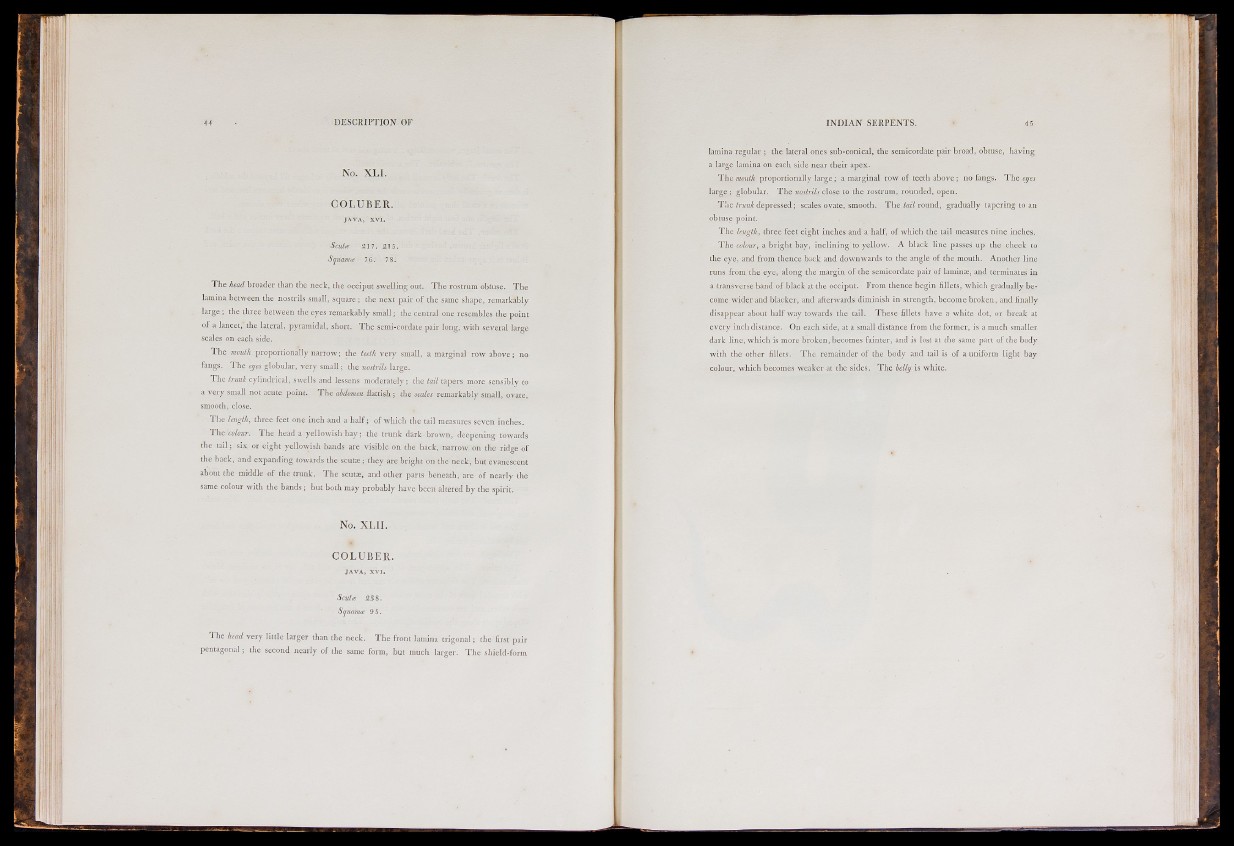
DESCRIPTION OF
No. XLI.
COLUBER.
JAVA, XVI.
Scuta: 317. 215.
Squamte 76. 7S.
The head broader than the neck, the occiput swelling out. The rostrum obtuse. The
lamina between the nostrils small, square; the next pair of the same shape, remarkably
large ; the three between the eyes remarkably small; the central one resembles the point
of a lancet, the lateral, pyramidal, short. The semi-cordate pair long, with several large
scales on each side.
The mouth proportionally narrow; the teeth very small, a marginal row above; no
fangs. The eyes globular, very small; the nostrils large.
The trunk cylindrical, swells and lessens moderately; the tail tapers more sensibly to
a very small not acute point. The abdomen flattish ; the scales remarkably small, ovate,
smooth, close.
The length, three feet one inch and a hal f ; of which the tail measures seven inches.
The colour. The head a yellowish bay; the trunk dark brown, deepenino- towards
the tail; six or eight yellowish bands are visible on the back, narrow on the ridge of
the back, and expanding towards the scuta:; they are bright on the neck, but evanescent
about the middle of the trunk. The scuta:, and other parts beneath, are of nearly the
same colour with the bands; but both may probably have been altered by the spirit.
No. XLII.
COLUBER.
Scuta 23 8.
Squamce 9 5.
The head very little larger than the neck. The front lamina trigonal; the first pair
pentagonal ; the second nearly of the same form, but much larger. The shield-form
I N D I A N SERPENTS. 4 5
lamina regular ; the lateral ones sub-conical, the semicordate pair broad, obtuse, having
a large lamina on each side near their apex.
T\\& mouth proportionally large; a marginal row of teeth above ; no fangs. The CT/«
large ; globular. The nostrils close to the rostrum, rounded, open.
Tlie ¡!nm;4 depressed ; scales ovate, smooth. The to7 round, gradually tapering to an
obtuse point.
The length, three feet eight inches and a half, of which the tail measures nine inches.
The colour, a bright bay, inclining to yellow. A black line passes up the cheek to
the eye, and from thence back and downwards to the angle of the mouth. Another line
runs from the eye, along the margin of the semicordate pair of laminae, and terminates in
a transverse band of black at the occiput. From thence begin fillets, which gradually become
wider and blacker, and afterwards diminish in strength, become broken, and finally
disappear about halfway towards the tail. These fillets have a white dot, or break at
every inch distance. On each side, at a small distance from the former, is a much smaller
dark line, which is more broken, becomes fainter, and is lost at the same part of the body
with the other fillets, The remainder of the body and tail is of a uniform light bay
colour, which becomes weaker at the sides. The belly is white.
i 1